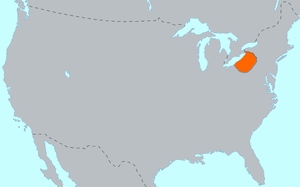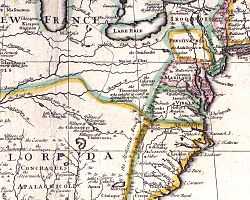Erie people

The Erie (also Erieehronon, Eriechronon, Riquéronon, Erielhonan, Eriez, Nation du Chat) were a Native American people historically living on the south shore of Lake Erie. An Iroquoian group, they lived in what is now western New York, northwestern Pennsylvania, and northern Ohio. They were decimated in the 17th century by warfare with the neighboring Iroquois, especially the Seneca, for helping the Huron in the Beaver Wars for control of the fur trade. The remaining Erie were absorbed by other Iroquoian tribes, particularly the Seneca, and gradually lost their independent identity. Their villages were burned as a lesson to those who dare oppose the Iroquois.
The names Erie and Eriez are shortened forms of Erielhonan, meaning "long tail." The Erielhonan were also called the Chat ("Cat" in French) or "Raccoon" people, referring to that characteristic. They lived in multi-family long houses in villages enclosed in palisades. They cultivated the "Three Sisters": varieties of corn, beans, and squash, during the warm season. In winter, tribal members lived off the stored crops and animals taken in hunts.
History

Clip from John Senex map ca 1710 showing the people Captain Vielle passed (1692–94) by to arrive in Chaouenon's country, as the French Jesuit called the Shawnee
While indigenous peoples lived along the Great Lakes for thousands of years in succeeding cultures, historic tribes known at the time of European encounter began to coalesce by the 15th and 16th centuries. The Erie were among the several Iroquoian-speaking nations. Competition among tribes for resources and power was escalated by the lucrative returns of the fur trade with French and Dutch colonists in the area. Violence increased between the tribes, who responded to demand for beaver and other furs by overhunting some areas.
The Erie encroached on territory other tribes considered theirs. They angered their eastern neighbors, the Iroquois League, by accepting refugees from Huron villages which had been destroyed by the Iroquois. Though rumored to use poison-tipped arrows (Jesuit Relations 41:43, 1655–58 chap. XI), the Erie were disadvantaged in armed conflict with the Iroquois because they had few firearms. (If the Erie tribe had used poison on their arrows, they would have been the only tribe in North America to do so.)[1] Beginning in the mid-1650s, the Iroquois Confederacy went to war against the Erie and neighboring competing tribes. As a result, they destroyed the Erie confederacy, with the tribes surviving in remnants. Dispersed groups survived a few more decades before being absorbed into the Iroquois, especially the westernmost Seneca nation.
Anthropologist Marvin T. Smith (1986:131–32) theorized that some Erie fled to Virginia and then South Carolina, where they became known as the Westo. Some were said to flee to Canada. Members of other tribes claimed later to be descended from refugees of this defunct culture, who intermarried with other peoples. Among those are members of the Seneca people in Oklahoma and Kansas.
Because the Erie were located further from the coastal areas of early European exploration, they had little direct contact with Europeans. Only the Dutch fur traders from Fort Orange (now Albany, New York) and Jesuit missionaries in Canada reported on them in historic records. The Jesuits learned more about them during the Beaver Wars. What little is known about them has been derived from oral history of other Native American tribes, archaeology, and comparisons with other Iroquoian peoples.
Language
The Erie spoke an Iroquoian language said to have been similar to Wyandot.
See also
Notes
- ↑ Tooker 1978 and Snyderman 1948, "doubts poisoned arrows". Anthony P. Schiavo, Claudio R. Salvucci, Iroquois Wars: Extracts from the Jesuit Relations and Primary Sources, p.11 ISBN 1-889758-37-X
References
- Bowne, Eric E. (2005). The Westo Indians: slave traders of the early colonial South. Tuscaloosa, Ala.: University of Alabama Press. ISBN 0-8173-1454-7. OCLC 56214192.
- Bowne, Eric E. (2006), "Westo Indians", The New Georgia Encyclopedia, Georgia Humanities Council and the University of Georgia Press
- Engelbrecht, William E. (1991), "Erie", The Bulletin: Journal of the New York State Archaeological Association (102): 2–12, OCLC 17823564
- Engelbrecht, William E.; Lynne P. Sullivan (1996). "Cultural context". In Lynne P. Sullivan (ed.). Reanalyzing the Ripley Site: earthworks and late prehistory on the Lake Erie Plain. New York State Museum Bulletin 489. Albany: University of the State of New York, the State Education Department. pp. 14–27 [volume References, 176–87]. ISBN 1-55557-202-2. OCLC 38565296.
- Hewitt, J. N. B. (1907), "Erie", in Frederick Webb Hodge (ed.), Handbook of American Indians north of Mexico, part 1, BAE Bulletin 30, Washington, D.C.: Government Printing Office, pp. 430–32
- Smith, Marvin T. (1987), Archaeology of aboriginal cultural change in the interior Southeast: depopulation during the early historic period, Ripley P. Bullen Monographs in Anthropology and History 6, Gainesville, Fla.: University Press of Florida, OCLC 15017891
- White, Marian E. (1961), Iroquois culture history in the Niagara Frontier area of New York State, University of Michigan Museum of Anthropology Anthropological Papers 16, Ann Arbor, Mich., OCLC 18903624
- White, Marian E. (1971), "Ethnic identification and Iroquois groups in western New York and Ontario", Ethnohistory 18 (1): 19–38, doi:10.2307/481592
- White, Marian E. (1978), "Erie", in Bruce G. Trigger (ed.), Handbook of North American Indians, Vol. 15: Northeast, Washington, D.C.: Smithsonian Institution, pp. 412–17
- Wright, Roy A. (1974), "The People of the Panther-a long Erie tale (an ethnohistory of the southwestern Iroquoians)", in Michael K. Foster (ed.), Papers in linguistics from the 1972 Conference on Iroquoian Research, Mercury Series Paper 10, Ottawa: National Museum of Man. Ethnology Division, pp. 47–118, OCLC 1429124
External links
- "Erie", Encyclopedia of Oklahoma History and Culture
- "Erie History", unreferenced amateur history by Lee Sultzman
| ||||||||||||||||||